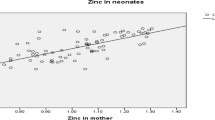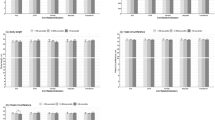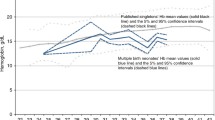Abstract
Our study aimed to assess the distribution of copper (Cu) in umbilical cord serum and estimated the association between umbilical serum Cu status and neonatal birth outcomes in a Chinese population. Through the Ma’anShan Birth Cohort Study, 2689 maternal-singleton pairs with detailed birth records and available serum samples were identified. The tertile levels of ln-transformed Cu were used to define low, medium, and high levels for serum Cu. The median for umbilical cord serum Cu was 298.2 μg/L with a range of 123.1–699.6 μg/L in this study population. Our study found a positive association between the concentration of serum Cu in the umbilical cord and the duration of gestation. Compared with medium Cu levels, we found that infants with low Cu levels had a significant higher risk of preterm birth (OR = 5.06, 95% CI 2.74, 9.34) and early-term birth (OR = 1.36, 95% CI 1.10, 1.69) in the crude model. We also found that infants with high Cu levels had a significant higher risk of late- or post-term birth (OR = 1.47, 95% CI 1.11, 1.95). A significant higher risk of preterm, early-term, and late- or post-term birth still remained, even after adjustment for potential confounding factors. Our findings suggested that both Cu deficiency and Cu overload had an adverse effect on neonatal birth outcomes.

Similar content being viewed by others
References
Blencowe H, Cousens S, Oestergaard MZ, Chou D, Moller AB, Narwal R, Adler A, Vera Garcia C, Rohde S, Say L, Lawn JE (2012) National, regional, and worldwide estimates of preterm birth rates in the year 2010 with time trends since 1990 for selected countries: a systematic analysis and implications. Lancet 379(9832):2162–2172. https://doi.org/10.1016/S0140-6736(12)60820-4
Romero R, Dey SK, Fisher SJ (2014) Preterm labor: one syndrome, many causes. Science 345(6198):760–765. https://doi.org/10.1126/science.1251816
American College of Obstetricians and Gynecologists (2013) ACOG committee opinion no 579: definition of term pregnancy. Obstet Gynecol 122(5):1139–1140. https://doi.org/10.1097/01.AOG.0000437385.88715.4a
Reddy UM, Bettegowda VR, Dias T, Yamada-Kushnir T, Ko CW, Willinger M (2011) Term pregnancy: a period of heterogeneous risk for infant mortality. Obstet Gynecol 117(6):1279–1287. https://doi.org/10.1097/AOG.0b013e3182179e28
Tita AT, Landon MB, Spong CY, Lai Y, Leveno KJ, Varner MW, Moawad AH, Caritis SN, Meis PJ, Wapner RJ, Sorokin Y, Miodovnik M, Carpenter M, Peaceman AM, O'Sullivan MJ, Sibai BM, Langer O, Thorp JM, Ramin SM, Mercer BM (2009) Timing of elective repeat cesarean delivery at term and neonatal outcomes. N Engl J Med 360(2):111–120. https://doi.org/10.1056/NEJMoa0803267
Uriu-Adams JY, Scherr RE, Lanoue L, Keen CL (2010) Influence of copper on early development: prenatal and postnatal considerations. Biofactors 36(2):136–152. https://doi.org/10.1002/biof.85
Araya M, Koletzko B, Uauy R (2003) Copper deficiency and excess in infancy: developing a research agenda. J Pediatr Gastroenterol Nutr 37(4):422–429
Gonzalez-Tarancon R, Calvo-Ruata L, Aramendia M, Ortega C, Garcia-Gonzalez E, Rello L (2017) Serum copper concentrations in hospitalized newborns. J Trace Elem Med Biol 39:1–5. https://doi.org/10.1016/j.jtemb.2016.06.010
Harvey LJ, McArdle HJ (2008) Biomarkers of copper status: a brief update. Br J Nutr 99(Suppl 3):S10–S13. https://doi.org/10.1017/s0007114508006806
Marriott LD, Foote KD, Kimber AC, Delves HT, Morgan JB (2007) Zinc, copper, selenium and manganese blood levels in preterm infants. Arch Dis Child Fetal Neonatal Ed 92(6):F494–F497. https://doi.org/10.1136/adc.2006.107755
Gambling L, McArdle HJ (2004) Iron, copper and fetal development. Proc Nutr Soc 63(4):553–562
Bermudez L, Garcia-Vicent C, Lopez J, Torro MI, Lurbe E (2015) Assessment of ten trace elements in umbilical cord blood and maternal blood: association with birth weight. J Transl Med 13:291. https://doi.org/10.1186/s12967-015-0654-2
Lewis SS, Keller SJ (2009) Identification of copper-responsive genes in an early life stage of the fathead minnow Pimephales promelas. Ecotoxicology 18(3):281–292. https://doi.org/10.1007/s10646-008-0280-3
Alebic-Juretic A, Frkovic A (2005) Plasma copper concentrations in pathological pregnancies. J Trace Elem Med Biol 19(2–3):191–194. https://doi.org/10.1016/j.jtemb.2005.08.002
Jauniaux E, Poston L, Burton GJ (2006) Placental-related diseases of pregnancy: involvement of oxidative stress and implications in human evolution. Hum Reprod Update 12(6):747–755. https://doi.org/10.1093/humupd/dml016
Vukelic J, Kapamadzija A, Petrovic D, Grujic Z, Novakov-Mikic A, Kopitovic V, Bjelica A (2012) Variations of serum copper values in pregnancy. Srp Arh Celok Lek 140(1–2):42–46
Ge X, Tao FB, Huang K, Mao LJ, Huang SH, Niu Y, Hao JH, Sun YL, Rutayisire E (2016) Maternal snoring may predict adverse pregnancy outcomes: a cohort study in China. PLoS One 11(2):e0148732. https://doi.org/10.1371/journal.pone.0148 732
Wang SF, Ge X, Zhu BB, Xuan YJ, Huang K, Rutayisire E, Mao LJ, Huang SH, Yan SQ, Tao FB (2016) Maternal continuing folic acid supplementation after the first trimester of pregnancy increased the risk of large-for- gestational-age birth: a population-based birth cohort study. Nutrients 8(8). https://doi.org/10.3390/nu8080493
Huebert D (2017) Definition of baseline chemistry: box plots of data are information rich. Integr Environ Assess Manag 13(2):446–448. https://doi.org/10.1002/Ieam.1872
Zhang Z, Yuan EW, Liu JJ, Lou XF, Jia LT, Li XF, Zhang LL (2013) Gestational age-specific reference intervals for blood copper, zinc, calcium, magnesium, iron, lead, and cadmium during normal pregnancy. Clin Biochem 46(9):777–780. https://doi.org/10.1016/j.clinbiochem.2013.03.004
Baqui AH, Rosen HE, Lee AC, Applegate JA, El Arifeen S, Rahman SM, Begum N, Shah R, Darmstadt GL, Black RE (2013) Preterm birth and neonatal mortality in a rural Bangladeshi cohort: implications for health programs. J Perinatol 33(12):977–981. https://doi.org/10.1038/jp.2013.91
Wang H, Hu YF, Hao JH, Chen YH, Wang Y, Zhu P, Zhang C, Xu YY, Tao FB, Xu DX (2016) Maternal serum zinc concentration during pregnancy is inversely associated with risk of preterm birth in a Chinese population. J Nutr 146(3):509–515. https://doi.org/10.3945/jn.115.220632
Carey JC, Klebanoff MA, Hauth JC, Hillier SL, Thom EA, Ernest JM, Heine RP, Nugent RP, Fischer ML, Leveno KJ, Wapner R, Varner M (2000) Metronidazole to prevent preterm delivery in pregnant women with asymptomatic bacterial vaginosis. National Institute of Child Health and Human Development Network of Maternal-Fetal Medicine Units. N Engl J Med 342(8):534–540. https://doi.org/10.1056/nejm200002243420802
Liang CM, Li ZJ, Xia X, Wang QN, Tao RW, Tao YR, Xiang HY, Tong SL, Tao FB (2017) Determine multiple elements simultaneously in the sera of umbilical cord blood samples—a very simple method. Biol Trace Elem Res 177(1):1–8. https://doi.org/10.1007/s12011-016-0853-6
Wells EM, Jarrett JM, Lin YH, Caldwell KL, Hibbeln JR, Apelberg BJ, Herbstman J, Halden RU, Witter FR, Goldman LR (2011) Body burdens of mercury, lead, selenium and copper among Baltimore newborns. Environ Res 111(3):411–417. https://doi.org/10.1016/j.envres.2010.12.009
Jones EA, Wright JM, Rice G, Buckley BT, Magsumbol MS, Barr DB, Williams BL (2010) Metal exposures in an inner-city neonatal population. Environ Int 36(7):649–654. https://doi.org/10.1016/j.envint.2010.04.007
El Marroun H, Zeegers M, Steegers EA, van der Ende J, Schenk JJ, Hofman A, Jaddoe VW, Verhulst FC, Tiemeier H (2012) Post-term birth and the risk of behavioural and emotional problems in early childhood. Int J Epidemiol 41(3):773–781. https://doi.org/10.1093/ije/dys043
Yang J, Huo W, Zhang B, Zheng T, Li Y, Pan X, Liu W, Chang H, Jiang M, Zhou A et al (2016) Maternal urinary cadmium concentrations in relation to preterm birth in the Healthy Baby Cohort Study in China. Environ Int 94:300–306. https://doi.org/10.1016/j.envint.2016.06.003
Brown HK, Speechley KN, Macnab J, Natale R, Campbell MK (2014) Neonatal morbidity associated with late preterm and early term birth: the roles of gestational age and biological determinants of preterm birth. Int J Epidemiol 43(3):802–814. https://doi.org/10.1093/ije/dyt251
Sengupta S, Carrion V, Shelton J, Wynn RJ, Ryan RM, Singhal K, Lakshminrusimha S (2013) Adverse neonatal outcomes associated with early-term birth. JAMA Pediatr 167(11):1053–1059. https://doi.org/10.1001/jamapediatrics.2013.2581
Edwards MO, Kotecha SJ, Lowe J, Richards L, Watkins WJ, Kotecha S (2015) Early-term birth is a risk factor for wheezing in childhood: a cross-sectional population study. J Allergy Clin Immunol 136(3):581–7.e2. https://doi.org/10.1016/j. jaci.2015.05.005
Bruckner TA, Cheng YW, Caughey AB (2008) Increased neonatal mortality among normal-weight births beyond 41 weeks of gestation in California. Am J Obstet Gynecol 199(4):421.e1–421.e\. https://doi.org/10.1016/j.ajog.2008.05.015
Frank R, Garfinkle J, Oskoui M, Shevell MI (2016) Clinical profile of children with cerebral palsy born term compared with late- and post-term: a retrospective cohort study. BJOG. https://doi.org/10.1111/1471-0528.14240
Perveen S, Altaf W, Vohra N, Bautista ML, Harper RG, Wapnir RA (2002) Effect of gestational age on cord blood plasma copper, zinc, magnesium and albumin. Early Hum Dev 69(1–2):15–23. https://doi.org/10.1016/s0378-3782(02)000 24-5
Schulpis KH, Karakonstantakis T, Gavrili S, Chronopoulou G, Karikas GA, Vlachos G, Papassotiriou I (2004) Maternal--neonatal serum selenium and copper levels in Greeks and Albanians. Eur J Clin Nutr 58(9):1314–1318. https://doi.org/10.1038/sj.ejcn.1601967
Algerwie MH, Khatri PC (1998) Serum copper in newborns and their mothers. Indian J Pediatr 65(6):899–903
Galinier A, Periquet B, Lambert W, Garcia J, Assouline C, Rolland M, Thouvenot JP (2005) Reference range for micronutrients and nutritional marker proteins in cord blood of neonates appropriated for gestational ages. Early Hum Dev 81(7):583–593. https://doi.org/10.1016/j.earlhumdev.2005.01.007
Tsuzuki S, Morimoto N, Hosokawa S, Matsushita T (2013) Associations of maternal and neonatal serum trace element concentrations with neonatal birth weight. PLoS One 8(9):e75627. https://doi.org/10.1371/journal.pone.0075627
Maia PA, Figueiredo RC, Anastácio AS, Porto da Silveira CL, Donangelo CM (2007) Zinc and copper metabolism in pregnancy and lactation of adolescent women. Nutrition 23(3):248–253. https://doi.org/10.1016/j.nut.2007.01.003
Izquierdo Alvarez S, Castañón SG, Ruata ML, Aragüés EF, Terraz PB, Irazabal YG, González EG, Rodríguez BG (2007) Updating of normal levels of copper, zinc and selenium in serum of pregnant women. J Trace Elem Med Biol 21:49–52. https://doi.org/10.1016/j.jtemb.2007.09.023
O'Brien KO, Zavaleta N, Caulfield LE, Wen J, Abrams SA (2000) Prenatal iron supplements impair zinc absorption in pregnant Peruvian women. J Nutr 130(9):2251–2255
Hawk SN, Lanoue L, Keen CL, Kwik-Uribe CL, Rucker RB, Uriu-Adams JY (2003) Copper-deficient rat embryos are characterized by low superoxide dismutase activity and elevated superoxide anions. Biol Reprod 68(3):896–903
Uriu-Adams JY, Keen CL (2005) Copper, oxidative stress, and human health. Mol Asp Med 26(4–5):268–298. https://doi.org/10.1016/j.mam.2005.07.015
Sultana Z, Maiti K, Aitken J, Morris J, Dedman L, Smith R (2017) Oxidative stress, placental ageing-related pathologies and adverse pregnancy outcomes. Am J Reprod Immunol. https://doi.org/10.1111/aji.12653
Zadrozna M, Gawlik M, Nowak B, Marcinek A, Mrowiec H, Walas S, Wietecha-Posluszny R, Zagrodzki P (2009) Antioxidants activities and concentration of selenium, zinc and copper in preterm and IUGR human placentas. J Trace Elem Med Biol 23(2):144–148. https://doi.org/10.1016/j.jtemb.2009.02.005
Challis JR, Lockwood CJ, Myatt L, Norman JE, Strauss JF 3rd, Petraglia F (2009) Inflammation and pregnancy. Reprod Sci 16(2):206–215. https://doi.org/10.1177/1933719108329095
Tao XY, Huang K, Yan SQ, Zuo AZ, Tao RW, Cao H, Gu CL, Tao FB (2016) Pre-pregnancy BMI, gestational weight gain and breast-feeding: a cohort study in China. Public Health Nutr:1–8. https://doi.org/10.1017/s1368980016003165
Ziaei S, Janghorban R, Shariatdoust S, Faghihzadeh S (2008) The effects of iron supplementation on serum copper and zinc levels in pregnant women with high-normal hemoglobin. Int J Gynaecol Obstet 100(2):133–135. https://doi.org/10.1016/j.ijgo.2007.07.026
Huang SH, Weng KP, Lin CC, Wang CC, Lee CT, Ger LP, Wu MT (2016) Maternal and umbilical cord blood levels of mercury, manganese, iron, and copper in southern Taiwan: a cross-sectional study. J Chin Med Assoc. https://doi.org/10.1016/j.jcma.2016.06.007
Acknowledgments
Funding was provided by the National Natural Science Foundation of China (No. 81330068, Beijing, People’s Republic of China) and the National Natural Science Foundation of China (No. 81573168, Beijing, People’s Republic of China).
Author information
Authors and Affiliations
Corresponding authors
Ethics declarations
All experimental procedures were approved by the institutional ethics committee of Anhui Medical University.
Conflict of Interest
The authors declare that they have no conflict of interest.
Additional information
Zhijuan Li and Chunmei Liang are the equal first authors.
Rights and permissions
About this article
Cite this article
Li, Z., Liang, C., Huang, K. et al. Umbilical Serum Copper Status and Neonatal Birth Outcomes: a Prospective Cohort Study. Biol Trace Elem Res 183, 200–208 (2018). https://doi.org/10.1007/s12011-017-1144-6
Received:
Accepted:
Published:
Issue Date:
DOI: https://doi.org/10.1007/s12011-017-1144-6




